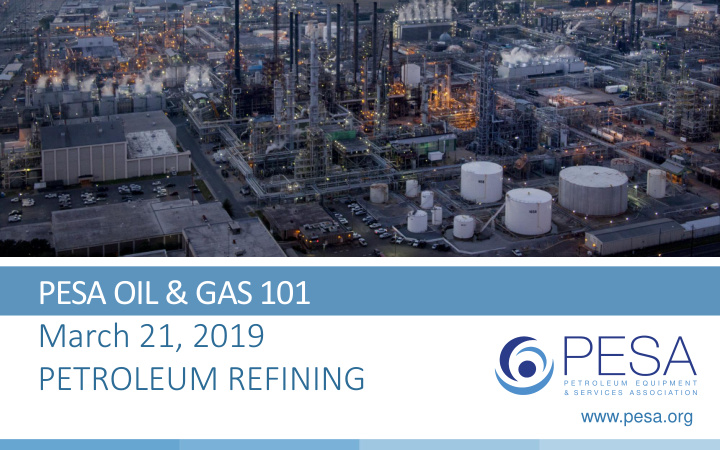



PESA OIL & GAS 101 March 21, 2019 PETROLEUM REFINING www.pesa.org
What Drives the Demand for Energy? Global energy demand Quadrillion BTUs 250 Average Growth/Year 0.7% 2015 to 2040 2040 200 Population 2015 1.5% Living Standards -0.1% 150 Technology 100 0.6% 2.6% 50 5.8% 0 Oil Gas Coal Other Nuclear Solar & Renewable 1 Wind Source: ExxonMobil 2017 Outlook for Energy
135 18.6 U.S. Refineries MBD operable capacity Source: U.S. Energy Information Administration
What’s in a barrel of crude?
“Flavors” of Crude Brent Mars West Texas Dubai Light, medium or heavy; sour or sweet
Transportation of Crude Rail Pipeline Sea
The Refining Process
Refining Process 1 Separation • Separates crude oil into naturally occurring components • Occurs by applying heat through a process called distillation • Performed in a series of distillation towers, with the bottom product from each tower feeding the next
Crude Distillation Unit 9
Refining Process 2 Conversion Converts low valued heavy oils into higher valued gasoline, distillates and feedstocks • Hydroformers change structure of naphtha molecules to improve octane and supply chemical feed requirements • Fluidized Catalytic Crackers (FCC) convert heavy gas oils into gasoline, diesel and chemicals feedstock • Coker Units convert asphalts into FCC Unit diesel and feedstocks
Refining Process 3 Purification • Sulfur removal from products • Hydrotreating – unfinished products are contacted with hydrogen under high pressure and heat to remove sulfur • End products that meet and exceed environmental standards Hydrotreater
Products Both finished products and feedstocks/basestocks Lubricants Diesel/Motor gasoline Jet fuel Plastics Tires Car dashboard
Summary • The world needs energy • Refining produces a diverse set of products through a diverse set of highly technical processes • Refining is a valuable part of our energy economy
Questions?
Recommend
More recommend